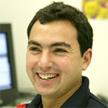
Yusuf Pisan
Oh no, we are down to 3 scientists already!
Favourite Thing: Write programs that I am not exactly sure what they will do. Sometimes they do what I expect them to do, other times they surprise me and I have to figure out why they do what they do!
My CV
School:
I grew up in Istanbul, Turkey and attended the local primary school. After a big national exam, I went to Robert College in Istanbul for middle and High School. It is a great high school: http://portal.robcol.k12.tr/
University:
I did my BSc (4 years) and Phd (6 years) at Northwestern University in Chicago. Started in 1988 finished in 1998 :-) http://www.northwestern.edu/
Work History:
Macquarie University / University of New South Wales / Northwestern University (USA)
Employer:
University of Technology, Sydney http://uts.edu.au/
Current Job:
Associate Professor in Game Design and Programming. I lead the Games Studio research group http://gamesstudio.org/ My personal web page is at http://gamesstudio.org/yusufpisan
Me and my work
Creating tools to make the next generation of games
Computer games are fun. We don’t always know what makes them fun, but we know that if we can make good games people will spend hundreds and hundreds of hours playing them, being entertained by them, sharing them with their friends. So, let’s find a way to make games both fun and educational.
You do not just play World of Warcraft. You collaborate with others. You learn how to put a good team together. You do not just play Civilization. You learn about managing resources, your supply lines, your comparative advantage. These are all very important skills. Much more important than memorizing your times tables or knowing when Cook first made it to Australia.
Let’s use lessons from game design to fix what is wrong with the world. If you want to know more about this, read Jane McGonigal’s book “Reality is Broken”
My Typical Day
6:30 wake up, play with my 2.5 year old son until 8am. Start work at 9am, read, discuss, think, write, meet students, back home by 6pm
Everything you wanted to know about me,
and were not to shy to ask!
Q: What was your first computer?
A: ZX Spectrum. It had 48K of memory. You had to connect it to the TV. You loaded and saved games by connecting it to a cassette player.
Q: What game are you currently playing?
A: Katamari is a great game http://en.wikipedia.org/wiki/Katamari_Damacy
I am currently playing Journey http://en.wikipedia.org/wiki/Journey_(2012_video_game) which is lots of fun. The producer for it is Robin Hunicke http://en.wikipedia.org/wiki/Robin_Hunicke ; we were at Northwestern University at the same time doing our PhDs. I visited her and thatgamecompany in Los Angeles a couple of years ago, so knowing the back story I am a bit biased about the game. But then it did win a whole bunch of awards as well http://thatgamecompany.com/games/journey/
I play Triple Town http://www.tripletown.com/ and Tiny Wings http://www.andreasilliger.com/ on my iPhone.
I don’t usually play first-person shooter games because I am not that fast anymore, plus they started looking all the same after a while.
Q: What made you want to be a scientist?
A: I did not set out to be a computer scientist. Here is how I ended up becoming a university professor and computer games researcher.
I played some video games when I was growing up, but I was not especially into games. My first computer was a ZX Spectrum http://goo.gl/feic4 You could program it using BASIC. We would type in pages and pages of programming code from magazines to play very simple games.
I studied Computer Science because I thought it would be fun. I never thought I’d work with computers for a living (Important life lesson: Do what you love!) After university, I thought I would study some more to be a teacher at university. Turns out you need a PhD and need to do a whole bunch of research to become a university professors, but I figured working with computers was fun, so I did that. I was not working in the area of games at this time. My research area was called “artificial intelligence”.
After I moved to Australia, I was looking for a more applied area for my research and I thought making the NPCs (non-playing characters) intelligent would be a good contribution. This is how I started working on games. There were very few people doing research on games in 1998, so I got to know almost all the people working in that area. These days there are hundreds and hundreds of researchers trying to make better games, so there are lots of new ideas every day.
Q: What was the first game you played?
A: Breakout. You get to hit a wall of bricks with a ball to break it. http://en.wikipedia.org/wiki/Breakout_(video_game)
Q: What language do you program in?
A: C, C++, C#, Java, Lisp, Perl, Php, python, javascript, and others. Language really does not make much of a difference. They are all the same once you understand how computers work.
Q: What is your favorite gaming console?
A: Wii. I have PS3, XBOX360 and others, but I think Wii is revolutionary because it went away from bigger CPU better graphics paradigm and created a platform for social physical games. Now all the consoles are following its lead. Shigeru Miyamoto is one of the game designers at Nintendo. He has created Mario, Donkey Kong, The Legend of Zelda, Star Fox, F-Zero, Pikmin, as well as the Wii series of games.
Q: What is the best part of your job?
For me it is the students.
The best part of my job is the students: undergraduate students, honours students, capstone students, masters students, and PhD students. They come in all shapes and sizes, but they are all exciting. They learn a bit from me and from others and then they go and do wonderful stuff in the world. Sometimes they even come back to talk about what they have been working on. Students force me to learn new things all the time.
That is my personal answer. At a more general level, being a “college professor” is often rated as one of the top 5 jobs (see http://money.cnn.com/magazines/moneymag/bestjobs/2009/full_list/index.html ) in terms of flexibility and work environment. Being a software engineer or computer systems analyst is also rated very highly http://www.careercast.com/jobs-rated/10-best-jobs-2012 and http://www.careercast.com/content/10-best-jobs-2012-9-computer-systems-analyst Don’t get me wrong. I do grumble plenty about work during grant writing times or when I have piles and piles of homeworks to mark, but overall it is great.
How about being a games programmer or a games artist? These are not yet well established job positions. For a while, everybody wanted to get into games and was willing to work 100 hours a week. This was not very healthy. It might have been fun for one project when you were trying to meet a deadline, but if it happens over and over, it can have serious consequences. A blog post in 2004 from EA_Spouse http://en.wikipedia.org/wiki/EA_Spouse criticized Electronic Arts about their work habits and led to changes in the game industry. IGDA (International Game Developers Association) now has a SIG (Special Interest Group) that looks at quality of life issues and works at http://www.igda.org/qol improving the conditions for game developers.
Have you played or do you know the game “LA Noire” that was produced in Sydney? There were some serious problems with the working conditions during development, more details at http://www.ingame.msnbc.msn.com/technology/ingame/l-noire-studio-accused-abusive-working-conditions-122387 Other development studios haven’t had such problems. For example, FireMint in Melbourne has released a few outstanding games without having such work issues http://firemint.com/about-firemint/
Q: Are batteries the only way to store energy?
A: When I have some extra energy, I carry a bucket of water up the stairs. This way when I need some energy, I can pour down all the water I have stored, have it go through a turbine and generate some electricity. My friends don’t think this is a great way to store energy. What do you think?
Classical mechanics tries to divide energy into “kinetic” energy and “potential” energy. This division is not perfect, but usually good enough. The water upstairs has potential energy. The water running down, going through the turbine has kinetic energy. More on different forms of energy at http://en.wikipedia.org/wiki/Forms_of_energy
Of course, having a swimming pool of water is not going to work well to power my car, so we need something else. Petrol and LPG (Liquid Petroluem Gas) are types of stored energy. They can store a lot of energy. Much better than my bucket of water solution. Unfortunately, once we burn them up and convert them to make our cars go. They are gone forever. There is no getting them back or recharging them.
What do we want out of our energy storage? 1) Easy to convert one form of energy to another, so we do not lose much energy in the conversion 2) Be compact, so we do not need lots of space and 3) Be rechargeable, so we can use the same materials again and again.
Batteries are a great source of storing energy. The innovation comes from having batteries from different materials. Donald Sadoway set out to find a better way to store energy. He has been working on this probelm for a couple of years and looks like he might have found a solution. Here is the video
http://www.ted.com/talks/lang/en/donald_sadoway_the_missing_link_to_renewable_energy.html It will take time, but this is the latest and most exciting research on new types of batteries.
There is also a great talk about wireless electricity at http://www.ted.com/talks/eric_giler_demos_wireless_electricity.html but that is more about electricity transmission than storage.
In the meantime, you might want to create your own battery out of lemons: http://www.quantumbalancing.com/news/lemon_battery.htm
Q: what type of games do you create
A: I do not usually make games, but we make game prototypes. The difference is that the prototypes are not commercial products. They are not as polished, but they do show an interesting idea, a new twist for games.
I teach game design and game programming and my students make games as part of their subject. They make card games with actual cards. They make board games, similar to monopoly and scrabble and they make electronic games that you can play on your computer. Some of these games are first-person-shooter, some are puzzles, some are racing games. Some of the games run on iPhones or on Android devices or XBOXes.
We use GameMaker http://www.yoyogames.com/ , Scratch http://scratch.mit.edu/ and Unity http://unity3d.com/ as the different game engines. We also use C# and XNA to write games from scratch. Here are some videos from student games: http://gamesstudio.org/category/student-work/game-design/
Q: what first inspired you to become a scientist?
I did not set out to be a computer scientist. Here is how I ended up becoming a university professor and computer games researcher.
I played some video games when I was growing up, but I was not especially into games. My first computer was a ZX Spectrum http://goo.gl/feic4 You could program it using BASIC. We would type in pages and pages of programming code from magazines to play very simple games.
I studied Computer Science because I thought it would be fun. I never thought I’d work with computers for a living (Important life lesson: Do what you love!) After university, I thought I would study some more to be a teacher at university. Turns out you need a PhD and need to do a whole bunch of research to become a university professors, but I figured working with computers was fun, so I did that. I was not working in the area of games at this time. My research area was called “artificial intelligence”.
After I moved to Australia, I was looking for a more applied area for my research and I thought making the NPCs (non-playing characters) intelligent would be a good contribution. This is how I started working on games. There were very few people doing research on games in 1998, so I got to know almost all the people working in that area. These days there are hundreds and hundreds of researchers trying to make better games, so there are lots of new ideas every day.
Q: what do you wear to work
Jeans & t-shirt. Once in a while more formal pants and long sleeve shirt. Sometimes shorts & t-shirt. There is really no dress code. I have been known to walk around barefoot around the office!
Q: what kind of science do you study?
How can we generate a map, a game level, automatically to suit player’s ability and interests? If somebody likes fighting, they should get more monsters to fight while others who like puzzles should get more puzzles.
How can we get the NPCs (non-playing characters) to act and talk just like your friends do, so they are valuable companions to you along the way?
How can we automatically detect if the user is having fun while playing the game? Can we build in some automatic ways to change the gameplay to make it more enjoyable?
Can we use Kinect, a piece of game technology, to measure how stable old people are when they are standing up so they do not have to go to the doctor to have their level of stability checked?
Can we build games that are clever enough to argue with you clever enough to let you model alternative what-if scenarios?
What kind of people play World of Warcraft (or any MMO), can we classify them and determine if the balance of users is skewed which would lead to the game environment not being fun?
What would it take for a computer to play a drawing game with you where the computer tries to guess what you are drawing and you try to guess what the computer is drawing?
Lots and lots of questions…
Q: what kind of gaming equipment will you be creating?
We are mostly working with software, but we do have some quirky pieces of hardware as well.
We have a teddy bear with wires coming out of its back that can respond to touch. These days all it does is beep when you touch her, so not very exciting. The goal was to create something similar to Keepon http://beatbots.net/project/keeponpro/ with the commercial version http://mykeepon.com/
We have a large multi-user touch table for collaborative storytelling that was displayed in the Powerhouse Museum http://www.betaspace.net.au/content/view/70/ and http://www.assimilate.net/ We are looking at different ways of creating stories collaboratively.
I also want to purchase some LittleBits http://littlebits.cc/ to experiment with them, but don’t have any yet..
Q: What do you do for fun?
I used to have free time, and then I had a child and he sucked it all up. These days I mostly spend my free time with my 2.5 year old son. We do cooking, cleaning, biking, going to museums, parks, flying kite, swimming, playing ball and stuff.
I like reading books, a combination of science fiction and actual science news. I have a Kindle for reading books which I really like.
For a while I was doing a lot of hiking. My wife and I hiked to Everest base camp in Nepal. That is 5,380 m (17,700 ft). You start getting altitude sickness, cannot sleep, have a hard time breathing, but it was lots of fun.
I also play games, but not spending that many hours playing games right now.
Q: Is there a way of creating a force field capable of reflecting bullets?
Yes, but it is not practical. It would be too large to move around, so instead of going on with your everyday business, you’d have to wait behind the forcefield to have somebody come and shoot a bullet at you. It would also consume too much energy, so you cannot have it on all the time. Well you could, but it would be really expensive. You’d be better off getting a steel door and closing it instead.
A bullet is a bit like a hammer. They are both made out of metal; however, the bullet is usually smaller and travelling much much faster than a hammer. A bullet is travelling at 180-1500 m/s http://hypertextbook.com/facts/1999/MariaPereyra.shtml That is 648-5400 km/hour so much faster than your average car which is what makes it hard to stop.
Q: is it possible to create a weapon the shoots pure energy?
We can shoot bullets. We can shoot water. We can shoot light. We can shoot microwaves. We can shoot a grenade and have it explode at a destination. Everything we shoot has some energy. Some of it is in the form of “kinetic energy” because of its velocity, some in the form of “potential energy” that is stored and might do some additional damage.
Let’s take a step back. Why are we shooting? Is it to kill a monster, to stop a tank, to disrupt a space ship? There might be better options than punching a whole through the object to disable it.
My favorite weapon is the Portal Gun. Alas, it is not real (yet!) It can create two portals that connect to each other, one blue and one orange. When you go through one, you end up at the other end. Would be a good trick to jump against a wall only to re-appear at a very different place, or fire at the feet of the monster to have them re-appear at the bottom of the sea! http://goo.gl/z3Dle
Q: what is the meaning of life
42! (But then @Dirk beat me to it. So, here is some homework. Go read The Hitchhiker’s Guide to the Galaxy. OK, maybe watch the movie that will also do, or at least play the game http://www.douglasadams.com/creations/infocomjava.html )
What made you think there was any meaning to life? What is the meaning of “tomato”? What is the meaning of “ghost”? What is the meaning of “velocity”? — Are these meaningful questions?
It might be best to think of “life” as a road trip. There are fun parts, there are boring parts. There are some bumpy unpaved parts, some parts with lots of traffic where everything goes slowly. Some turns and twists, some choices and some cliffs, some people you meet along the way, and some you lose after a time. All we know is that at some point this trip will finish, so make sure you are enjoying yourself along the way.
Q: Do you believe that with the correct funding that it would be possible to create a stable worm hole?
There are some things money cannot buy. I suspect that stable worm holes might be one of those things for 2012. But, don’t lose hope. Come back in 100 years and we might have a different answer.
Building knowledge takes time. We just don’t know where to start with the stable wormhole business. We can build some flying bikes with much less money, so maybe that is where we should spend the funds: http://goo.gl/AFXhY
What I'd do with the money
Build a game with *you* in it, or better yet teach you how to build a game, so you can put whoever you want in it!
Building a game is not hard, in fact it is lots of fun. I have been using Scratch with primary school kids and trying to get more teachers to use Scratch in the classroom.
I would put together a set of “how to” videos, so you can make your first game in 1 hour or less. I would setup a forum, so if anybody is stuck they can get help easily. This way everybody can make their own game. This game won’t be as fancy as Minecraft or as popular as Farmville, but it will be your game with the pictures you put in there!
My Interview
How would you describe yourself in 3 words?
Who is your favourite singer or band?
What is the most fun thing you've done?
If you had 3 wishes for yourself what would they be? - be honest!
What did you want to be after you left school?
I wanted to be a teacher, maybe a high-school teacher. But then I decided I would study computers for fun and then go into “business” to make money. I liked university so much, I decided to stay and became a professor instead!
Were you ever in trouble in at school?
No, not in any serious way. I cheated (in some subjects), skipped school, finished assignments on the bus ride to school, but never really got in trouble.
What's the best thing you've done as a scientist?
Inspire others
Tell us a joke.
Q: How many game designers does it take to change a light bulb? A: No, no. Players change light bulbs. We just create incentives for them to do so. *****Q: How many producers does it take to change a light bulb? A: Changing the light bulb isn’t critical path, so don’t expect it before beta. *****Q: How many programmers does it take to change a light bulb? A: That code hasn’t been checked in yet. *****Q: How many art directors does it take to change a light bulb? A: Does it have to be a light bulb? *****Q: How many artists does it take to change a light bulb? A: Three. One to model the light bulb, one to texture-map the light bulb, and one to animate the light bulb. *****Q: How many Q/A people does it take to change a light bulb? A: Content issue/Non-critical. In the previous joke, this was artists. Is that a problem?
Sports followed
Favourite team
My profile link:
https://lithium.imascientist.org.au/profile/yusufpisan/







 Print this profile
Print this profile